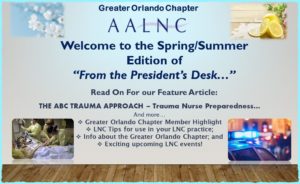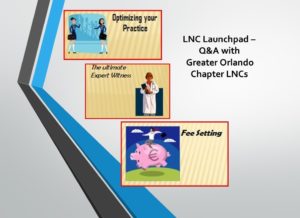
The ABCs of Trauma…From the ED Nurse Perspective
by
Amanda Freeman, RN
Imagine you are the nurse working in the emergency department, and the call comes in from EMS over the radio. You hear them say, “This is County Rescue 99. We have a 20-year-old female involved in a motor vehicle crash. She was extracted from her car. A bystander reports the car flipped three times. The windshield was shattered and the patient is positive for loss of consciousness. Right now, she is alert but confused. She has multiple lacerations to the left arm, her blood pressure is 98/60, heart rate is 120, and her oxygen saturation is 98% on room air. The estimated time of arrival (ETA) is about 5 minutes. How do you copy? Then you hear on the overhead speaker, “Trauma activation ED, trauma activation ED.” You watch as your coworkers put on gowns and gloves and head to the trauma room to prepare for what is about to come.
Why does this patient qualify as a trauma patient?
According to the national guidelines for field triage, patients with any one of the following injuries meet the criteria for a high-risk trauma patient, and should be transported to the highest-level trauma center available.
- Penetrating injuries to the head, neck, torso, and proximal extremities.
- Skull deformity or suspected skull fracture.
- Suspected spinal injury with new motor or sensory loss.
- Chest wall instability, deformity, or suspected flail chest.
- Suspected pelvic fracture.
- Suspected fracture of two or more proximal long bones.
- Crushed, degloved, mangled, or pulseless extremity.
- Amputation proximal to wrist or ankle.
- Active bleeding requiring a tourniquet or wound packing with continuous pressure.
- All patients who are:
- Unable to follow commands (motor Glasgow coma scale less than 6.)
- Respiratory rate less than 10 or more than 29 breaths per minute.
- Respiratory distress or need for respiratory support.
- Room-air pulse oximetry less than 90%.
- Ages 0-9 years: systolic blood pressure less than 70 mm Hg + (2+ age in years.)
- Ages 10-64 years: systolic blood pressure less than 110 mm Hg or heart rate greater than systolic blood pressure.
A moderate-risk trauma patient is any patient who meets the following criteria, and should be transported, preferentially, to a trauma center, but need not be the highest-level trauma center:
- High-Risk auto crash
- Partial or complete ejection.
- Significant intrusion (including room-more than 12 inches at occupant site, or more than 18 inches on any site, or need for extrication for entrapped patient.)
- Death in the passenger compartment.
- Child (age 0-9 years) unrestrained or in an unsecured child safety seat.
- Vehicle telemetry data consistent with severe injury.
- Rider separated from transport vehicle with significant impact (e.g., motocycle, ATV, horse, etc.)
- Pedestrian/bicycle rider thrown, run over, or with significant impact.
- Fall from a height of more than 10 feet.
Risk Factors to consider include:
- Low-level falls in young children (age 5 years or younger) or older adults (age 65 years or older) with significant head impact.
- Anticoagulant use.
- Suspicion of child abuse.
- Special, high-resource healthcare needs.
- Pregnancy of 10 weeks or more.
- Burns in conjunction with trauma.
How is the trauma nurse’s assessment different from a normal (non-trauma related) assessment?
There are two major parts to the trauma nurse’s assessment of a trauma patient – the primary survey and secondary survey.
With any part of a trauma assessment, the nurse is always inspecting, auscultating, and palpating. This is where the ABCs come in handy. In the primary survey, the nurse assesses for:
- A. Airway and alertness, with simultaneous cervical spine protection: This starts as soon as the nurse sees the patient. Immediate assessment includes indications of uncontrolled hemorrhage, airway status, and alertness. (This occurs while the nurse is simultaneously stabilizing the patient’s cervical spine.)
- B. Breathing and ventilation: Some things to consider in the assessment, include any contusions, abrasions or deformities to the chest; an open pneumothorax; jugular vein distention; and the position of the trachea.
- C. Circulation and control of hemorrhage: Muffled heart sounds could suggest pericardial tamponade. Assessment should include any obvious external hemorrhaging or pale skin color, and evaluation of central pulses for rate, rhythm and strength (whether they are bounding or weak.)
- D. Disability (neurological status), which can be assessed by using the Glasgow Coma Scale and assessing pupils for PERRLA.
- E. Exposure and environmental control, by carefully and completely undressing the patient to facilitate a thorough assessment; performing a quick visual scan to detect any uncontrolled bleeding, and maintaining the body temperature of the patient.
- F. Full set of vital signs and family presence.
- G. Get appropriate monitoring devices: L – obtain Labs; M – Monitor for continuous, cardiac rhythm and rate assessments; N – Nasogastric or orogastric tube consideration; O – Oxygenation and ventilation analysis; and P – Pain assessment and management.
In the secondary assessment, the trauma nurse considers H – J.
- H. Obtain a History and head-to-toe assessment. Much of the head-to-toe examination is performed in the primary phase. However, you still want to systematically move from the patient’s head to their lower extremities to identify all injuries.
- I. Inspect posterior surfaces. This is only done once the patient has been cleared of any spinal injuries, pelvic fractures, or any other injuries that can be exacerbated by movement. In injuries are confirmed, logrolling may be contraindicated. When examining the posterior surface, the nurse should look for puncture wounds, impaled objects, scars along the entire posterior surface, and presence of blood in or around the rectum.
- J. Just keep reevaluating. Trauma patients require ongoing monitoring. Just because the patient looks stable during the initial assessment, and all life-threatening injuries have been identified and appropriately treated, does not mean that the patient is stable. Reevaluation of patient status and response to interventions and treatments is ongoing and includes reevaluation of the primary survey, vital signs, level of pain, and other injuries identified in the secondary survey.
When to get a trauma expert? A case may warrant a trauma expert review when there is:
- Failure to correctly monitor a patient.
- Failure to follow policies and procedures.
- Failure to report critical laboratory results to the emergency room physician.
- Failure or delay in reporting changes in patient assessment.
- Medical delays or errors.
- Delay in acting on medical orders.
- Failure to document.
Unintentional injuries remain the fifth leading cause of death among people of all ages in the United States. Without proper assessment of a trauma patient, it can be easy to miss injuries that may lead to permanent injury, disability, or even death. The initial stabilization and resuscitation of a critically injured trauma patient is one of the most challenging situations that emergency nurses encounter. A trauma-certified nurse contributes to optimal patient outcomes and the prevention of long-term complications and death.
(Sources for this article are included in the Side Bar.)
Amanda Freeman, RN
Freeman Nurse Consulting, INC.
About the Author: Amanda Freeman is a diligent nursing professional who brings a strong foundation of medical knowledge and patient care expertise to the field of legal nurse consulting. With over 10 years of experience, she has been trained in critical care treatment and patient care and has extensive knowledge of Emergency Nursing and Level II Trauma Center patient acuity. She is highly qualified to provide clients with an understanding of nursing standards of care in the Emergency Department setting.
__________________________________________________________________________________
CHAPTER MEMBER HIGHLIGHT
KATELYN GROSSO, BSN, RN

Katie Grosso is the founder and owner of Elevation Consulting, LLC. She is a highly skilled acute care nurse, with over 12 years of experience in the hospital setting. She currently resides in southern New Hampshire, and works in the Cardiac Cath Lab in an academic medical center in the greater Boston area. Her background includes medical-surgical trauma/acute-care surgery, cardiovascular intensive care, medical device education, and travel nursing. Her dedication to providing high quality care and being a strong patient advocte has carried into her legal nurse consulting business, which she started just over a year ago. Her primary case work has been providing behind the scenes work to personal injury plaintiff clients. She joined the Greater Orlando Chapter last year, and recently signed on as a Social Medial Committee Member. When she’s not at the hospital, or in her home office wondering if she can really be a business owner, you can likely find her hiking up a beautifully rugged peak in the White Mountains, pretending she knows how to surf out on the NH seacoast, sledding down a ski mountain through sketchy New England snow conditions, or paddle boarding down the river with her adventurous four-year-old niece.
_______________________________________________________________________________

LNC PROFESSIONAL DEVELOPMENT
AALNC and Chapters – GoTo Source
AALNC and the Chapters are THE GO TO sources for networking and professional development in the field of legal nurse consulting. Want to learn of career opportunities? Want to stay up to date with the LNC industry trends? Want to hone your LNC skills and learn new ones? Then go to AALNC at https://aalnc.org and join now! Then go to https://orlandoaalnc.org and join our Chapter! And you can join ALL of the AALNC Chapters – for unlimited networking!
WE ARE NEAR YOU! Maybe not geographically, but through your computer or phone. The Greater Orlando Chapter has members in 30 States, Puerto Rico, and Canada! SINCE 2014, The Greater Orlando Chapter’s live Chapter Meetings with CE Programs have been broadcast virtually! Members and guests have been attending from all over the Country since then! Because of COVID, since 2020 all of our CE Programs have been virtual only.
Greater Orlando Chapter Membership Cycle goes from May to May of each year, with membership renewal being May 31. With this cycle, members who joined in 2024, will renew their membership NLT May 31, 2025. CONTACT US:
Email us at: info@orlandoaalnc.org
Or visit us at: https://orlandoaalnc.org
______________________________________
CONNECT WITH US
Connect with us on LinkedIn
Check us out at: https://orlandoaalnc.org
Contact us at: info@orlandoaalnc.org
Resources for The ABCs of Trauma…
1. Emergency Nurse Association. (2020) TNCC: Trauma nursing core course: Provider manual eighth edition. Jones & Bartlett Learning.
2. Newgard, Craig D. MD, MPH, FACEP; Fischer, Peter E. MD; Gestring, Mark MD; Michaels, Holly N. MPH; Jurkovich, Gregory J. MD, FACS; Lerner, E. Brooke PhD, FAEMS; Fallat, Mary E. MD; Delbridge, Theodore R. MD, MPH; Brown, Joshua B. MD, MSc, FACS; Bulger, Eileen M. MD; the Writing Group for the 2021 National Expert Panel on Field Triage. National guideline for the field triage of injured patients: Recommendations of the National Expert Panel on Field Triage, 2021. Journal of Trauma and Acute Care Surgery 93(2):p e49-e60, August 2022. | DOI: 10.1097/TA.0000000000003627.

Be sure to check out our new publication, “SAVE THE DATES.” This new publication includes LNC education programs offered by AALNC, and ALL of the AALNC Chapters! We are so excited for this joint Chapter activity! Watch for the next edition, coming to your inbox soon! In the meantime:
1) Register now for our program, “Navigating Complexity: Practical Report Writing Tips for the LNC,” Friday, June 21, 2024 from 5:00 – 8:00 PM, Eastern, and June 22, 2024, from 11:00 AM – 2:00 PM, Eastern, presented by Kenyetta Christmas, MSN, RN, ACNP-BC, CLNC and Tory Palivoda, BS, RN, LNCC.
2) Don’t forget our On-Demand Webinars. We have 15 On-Demand Webinars which are free for Chapter members and only $15 for non-Chapter members.
3) And check out the 2024 education programs from our fellow AALNC Chapters:
- Bay Area Chapter of Northern California at: https://www.bacn.org
- New Jersey Chapter at: https://njaalnc.org/
- Pittsburgh Chapter at: https://aalncpittsburgh.org
- Tampa Bay Chapter at: https://tbaalnc.org
- Pacific Northwest Chapter at: https://www.pnw-aalnc.com
AND, if you have not already done so, REGISTER NOW for AALNC Jumpstart 2024 Virtual Workshops! More below on this!
CONTINUING EDUCATION INFO
The Greater Orlando Chapter of AALNC is an approved provider of Nursing CE through the Florida Board of Nursing and CE Broker, and approved by the following States: Arkansas, District of Columbia, Florida, Georgia, Kansas, Kentucky, Mississippi, New Mexico, South Carolina and West Virginia. We report CE directly to CE Broker in these states. For attendees from other States, we provide required documents for self-reporting CE to State Boards of Nursing.
LNC LAUNCHPAD – Q&A with Greater Orlando Chapter LNCs

In 2021 we started a new program for members, which we call “LNC Launchpad – Q&A with Greater Orlando Chapter LNCs.” This is a 1.5 hour session to provide guidance, answer questions, and suggestions. We limit the event to 10 participants, so we can mentor each attendee – whether new to the LNC practice or experienced and ready for a change – we are there for you! The 2024 season is under way. Registration for the September 10, 2024 session will open on August 16th. Stay tuned!
1) September 10, 2024
2) November 12, 2024

LNC Tips Your LNC Tips this edition include a heads up about an awesome event to enhance your LNC Business… JUMPSTART 2024!
This program will provide a mixture of LNC clinical, LNC practice, and LNC business education and mentoring to start or grow your beginning LNC career. The interactive virtual workshop is built to provide business and marketing tips to help attendees create a strong LNC foundation, on which to apply the nursing process to their LNC practice. LNC Jumpstart is structured with LNC faculty to provide educational content on subjects including what legal nurse consulting is and what it isn’t, LNC work product overview, getting started as an LNC, and the LNC as a nursing expert witness and behind-the-scenes LNC.
MEET THE 2024 GREATER ORLANDO CHAPTER OFFICERS
AND DIRECTORS

President: Robin Axtell, BSN, RN, LNCC
President Elect: Michelle Gaines, MNA, RN, CRNA
Immediate Past President: Tory Palivoda, BS, RN, LNCC
Secretary: Alyssa Brandeberry, RN, LNCC
Treasurer: Patty Mitchell, BSN, RN, CLNC
DAL: Pamela Borello, BSN, RN, CNOR, CNAMB, CSSM(e)
DAL: Kenyetta Christmas, MSN, RN, ACNP-BC, CLNC
DAL: Christine Dorman, DNP, APRN, ACNP-BC, CCRN
DAL: Jillian Talento, BSN, RN, CEN, LNCC
DAL: Judy A. Young, MSN, MHL, RN, LNCC

ABOUT THE GREATER ORLANDO CHAPTER OF AALNC
The American Association of Legal Nurse Consultants (AALNC) was founded in 1989, as a not for profit membership organization dedicated to the professional enhancement and growth of registered nurses practicing in the specialty of legal nurse consulting. Chapter development quickly followed. The Orlando community was rich with nurses already practicing in the field of legal nursing. This group of committed professionals quickly became members of the new national organization and recognized the need for a local chapter. The Greater Orlando Chapter of AALNC, founded in 1989, was the second chapter formed under the new national organization. The Chapter was begun in support of AALNC’s mission, by providing networking opportunities, mentoring and support to nurses through professional development and education – a mission that is continued to this day.

